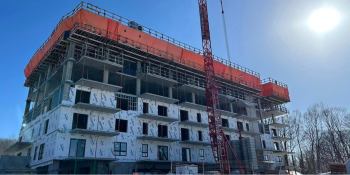Q&A Forums
Questions Post New Topic | Post Reply
| Author | Comments |
|---|---|
|
Nicholas Browning
Posted: Jun 07, 2008 07:01 PM
|
Questions
Thank you in advance for considering my questions. The information you have presented in the other topics has been very worthwhile.I am currently building a 3300 sq ft house in Grass Valley and I am interested in using spray foam insulation. My current contractor is not so thrilled with it given the expense. Starting from the top of the house: 1. The roof sheathing has a radiant barrier already applied, and the contractor feels that spraying the foam in the rafter bays would not only negate the radiant barrier advantage (I believe that to be true) but would also create a condensation point at the barrier/foam interface which would lead to sheathing rot. He also feels that a certain amount of ventilation would be necessary if the attic space were sealed up - in other words, some air would need to be exchanged between the living space of the house and the attic so that excess moisture could be removed. Is he correct, or is he worrying about something that isn't likely? 2. I have seen in multiple posts that a flame resistant barrier is required in attic applications - in other words, the foam must be covered with some sort of flame resistant material. Is blown-in cellulose sufficient? Is it reasonable to spray an inch or two of foam and get the rest of the R-38 out of blown in cellulose? It sure would be easier than doing batts. 3. One local insulation company is just starting to do spray foam insulation and they are okay with doing 1-2 inches of spray foam in the walls and following up with batts. Is this a reasonable way to go? 4. My contractor feels that spraying the floor joists is a complete waste of money as far as the air infiltration is concerned. He states that the floor is constructed with a tongue and groove design with glue in the joints, and he has also glued the rim joist to the subfloor as well. If one of the great advantages of spray foam is its greater ability to stop air infiltration then it does seem as he may be correct in that part of the house. Plumbing and electrical penetrations would be sealed in any case. 5. There are a couple of companies (Tigerfoam, Fomo) that sell DIY kits. These kits seem to work out to about $1.00 / board foot. It would seem that applying 1-2 inches of spray foam myself would not be all that hard in the walls or the floor joists (there is a lot of room in the crawlspace, it's more of a walkspace), but getting the area between the trusses after the ceiling has been drywalled would be a real pain. Maintaining the temperature of the tanks would not be a problem, but if the answer from folks is that a project of this magnitude would be very unwise then I'll see about getting more quotes from other contractors. 6. There is a local spray foam contractor who has had a bad experience where he applied closed cell foam to a drywalled ceiling and several months later, the foam shrank and ruined the ceiling drywall. He will no longer apply closed cell in that application (because he had to make good on the drywall), despite several jobs before with no adverse problems. Was this just a fluke? He claims he didn't apply it too thick, etc. Thanks again to any and all who answer. I appreciate your time and knowledge. |
|
mason
Posted: Jun 07, 2008 10:03 PM
|
The radiant barrier is not required when using SPF and I would remove it. (SPF refracts radiant energy very well) Just spray directly to the underside of the roof deck. With SPF it works better if you do not vent the attic. This also controls moisture better. SPF allows a slow controlled rate of moisture that goes into and out of the foam (depending on the seaon) without condensing. The sprayfoam separates the temperature while slowing down the moisture rate so the dewpoint is not within the foam or the interior of the building. SPF does require an ingition barrier in attics. Buildiings specifiy this a 1.5 inches of mineral fiber, 1/4 inch of wood paneling, 3/8 inch of drywall or a material that has been tested and approved by ICC Evaluation Services (some intumescent paints have achieved this approvale.) The sprayfoam is most effective in attics, cathedral ceilings and basements. Less effective in walls. So I disagree with installing it in walls and not the attic. Closed cell foam should not shrink as you describe, the foam was not installed correctly or was off spec. I strongly recommend against do it yourself applications. Check out articles on my website masonknowles.com |




























